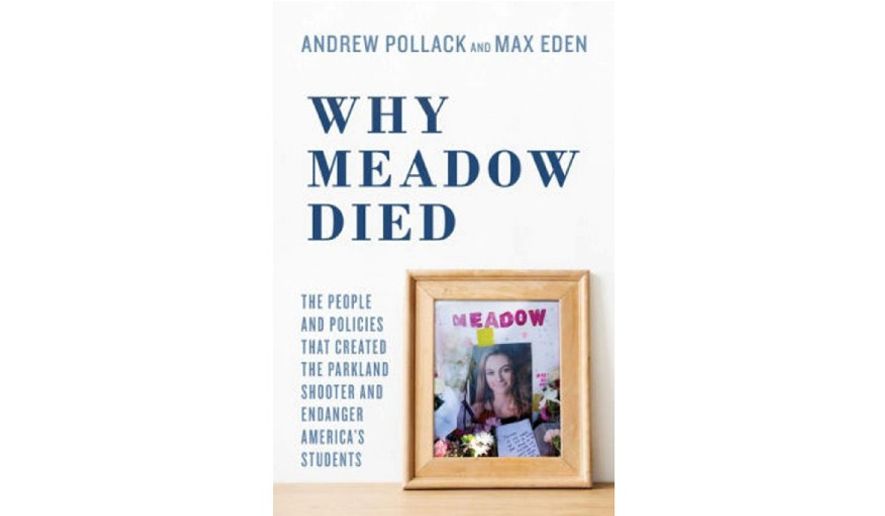OPINION:
A sick person killed 17 people at Marjory Stoneman Douglas High School in Parkland last year. Conventional wisdom is that enacting various gun control laws, including banning assault weapons, is the solution to school shootings.
But as Andrew Pollack, the father of one of the Parkland victims, and Max Eden, an education policy expert, explain in their new book “Why Meadow Died: The People and Policies that Created the Parkland Shooter and Endanger America’s Students,” the story is far more complicated than that.
As the book’s title suggests, government policy bears significant blame for the Parkland tragedy.
The shooter, Nikolas Cruz, showed serious signs of violent and erratic behavior for years. He mutilated animals, brought bullets to school, made death threats and attempted suicide. And everyone — local and federal law enforcement, school staff, teachers, students and his family — knew it.
Police officers were called to his house 45 times before the tragedy. His mother’s friend called the sheriff’s office, telling them “this might be Columbine in the making” — but they never called her back. Multiple students reported Cruz to school leaders. And the school security staff even had a meeting where they agreed that if anyone would become a school shooter, it would be Cruz.
If everyone knew something was wrong, how did he slip through the cracks?
As Mr. Pollack and Mr. Eden write, “Every institution around Cruz, especially the school system, failed.”
On their own, each government failure was arguably a rational response to the incentives created by well-intentioned but flawed government policies. For example, Broward school district’s PROMISE program had a well-meaning goal: Lower petty arrests in schools to prevent students from getting criminal records that would hurt them in life.
School officials knew Cruz got into a fight at school, vandalized school property and made death threats, yet he was never arrested.
District policy also required schools to send students to the juvenile justice system if they skipped the PROMISE program. Cruz was referred to the PROMISE program, but he did not attend nor was he sent to the juvenile justice system. If Cruz had earned a criminal record for any of these acts, local police and the FBI might have taken reports of his subsequent death threats more seriously. And if Cruz had felonies on his record, he would not have been able to legally purchase a gun.
But that’s just the tip of the iceberg.
Guidance from the federal government also had an honorable goal of preventing discriminatory discipline and reducing the number of suspensions and expulsions. A federal Dear Colleague Letter pressured schools to avoid disproportionately punishing students from different groups, including minority students and those with disabilities.
However, for “emotional and behavioral disabilities,” the guidance essentially pressured schools “to discipline students who behave badly at the same rate as students who behave well, which creates predictably perverse incentives and consequences,” Mr. Pollack and Mr. Eden write.
Similarly, the federal Individuals with Disabilities Education Act’s pressure to place students in the “least restrictive environment” might have inadvertently contributed to the school’s principal at Cruz’s alternative school deciding to put Cruz back into the regular high school, where support staff knew he didn’t belong. Likewise, the Youth Emergency Services group evaluated Cruz three times but decided he didn’t need to be institutionalized.
Then on the day of the shooting, there were several publicized government failures. A school security officer saw Cruz enter the campus with a rifle bag and heard shots, but never called Code Red because he claimed he didn’t want to “get the cops out there for nothing.” Eight Broward sheriff’s deputies heard shots but none of them went in the building to face the shooter, perhaps because the policy had recently changed from saying deputies “shall” enter a building to address a shooter to saying that they “may.”
Law enforcement failed. In other instances, well-intentioned school and government employees were just doing their jobs but the government’s top-down incentives and lack of accountability increased the chances of this tragedy. It is possible that Cruz would have killed 17 people, including Mr. Pollack’s daughter, Meadow, even without these failures and perverse incentives in place. But it would be irresponsible not to consider that even the most well-intentioned government policies often come with unintended and, in this case, fatal consequences.
• Corey A. DeAngelis is the director of school choice at Reason Foundation and an adjunct scholar at Cato Institute. You can reach him on Twitter at @DeAngelisCorey and via email at Corey.DeAngelis@Reason.org.
• • •
WHY MEADOW DIED: THE PEOPLE AND POLICIES THAT CREATED THE PARKLAND SHOOTER AND ENDANGER AMERICA’S STUDENTS
By Andrew Pollack and Max Eden
Post Hill Press, $27, 336 pages




Please read our comment policy before commenting.